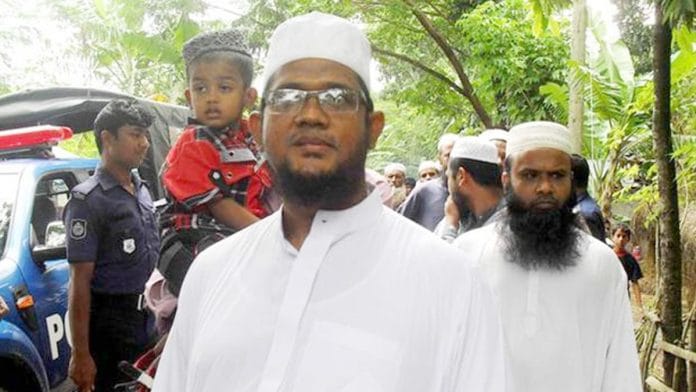New Delhi: Jashimuddin Rahmani, chief of the Islamist outfit Ansarullah Bangla Team (ABT), has been freed by the Muhammad Yunus-led interim government in Bangladesh.
Rahmani is convicted for abetting the murder of a blogger-activist, and a vocal supporter of the terror outfit Al-Qaeda and its offshoot Al Qaeda in the Indian Subcontinent (AQIS).
He was released Monday from Gazipur’s Kashimpur High Security Central Jail, where he had been lodged since August 2013, when he was arrested on the charge of abetting the murder of blogger Rajib Haider. He was blamed for multiple such targeted killings of secular bloggers and journalists between 2013 and 2016, for which ABT claimed responsibility.
He is also one of the several high-profile prisoners from the Sheikh Hasina-led Awami League era either released or cleared of all charges by the new interim government.
Before Rahmani, Begum Khaleda Zia, former Bangladesh prime minister and chief of the principal opposition party, Bangladesh Nationalist Party (BNP), was also released. Zia had been sentenced to 17 years in prison on corruption charges. She was freed right after the fall of Hasina’s government and escape to India on 5 August.
The same day, the military-led government had also released two prominent faces linked to Jamaat-e-Islami—Brigadier General Abdullahil Aman Azmi and lawyer Ahmad Bin Quasem—who were allegedly subjected to forced disappearance by the Hasina-led government in August 2016 and lodged in Aynaghar, a secret high-security prison.
Besides Jamaat and BNP leaders, Michael Chakma, a United People’s Democratic Front leader, was also released from Aynaghar. He had allegedly ‘disappeared’ in April 2019.
Also Read: On Dhaka’s streets, palpable anger toward India for ‘sheltering’ Hasina, acting ‘superior’
Freed & re-arrested in January
Charged with terrorism and murder charges in six cases filed against him, Rahmani was released on bail on 21 January this year. However, his freedom was short-lived.
He was re-arrested two days later for abetting terrorism after the Counter Terrorism and Transnational Crime (CTTC) unit arrested members of his outfit ABT, who had reportedly admitted to have joined the radical outfit after being inspired by his speeches.
He was convicted in December 2015 and handed a five-year jail term for abetting the murder of blogger Rajib Haider in 2013. Pending trial in five other cases linked to terrorism implied that he had to remain lodged in the jail.
According to reports in Bangladeshi media, all such cases against Rahmani have now been withdrawn paving the way for his release.
Investigating officers in the Rajib Haider murder case had said that private university students had “vowed to kill atheist bloggers” after reading Rahmani’s books and hearing his sermons. Rahmani, reportedly, used to issue sermons every Friday, saying that it was “legal” to kill any atheist or person against Islam and Prophet Mohammed.
Rahmani’s ABT had taken responsibility for the murders of several bloggers and writers, such as Avijit Roy, Oyasiqur Rahman Babu, Ananta Bijoy Das, and AKM Shafiul Islam, a professor of Rajshahi University between 2013 and 2016.
The outfit was banned by the Hasina-led government in 2016 for terrorist and anti-state activities.
A metropolitan judge in November 2016 indicted Rahmani and eight other ABT members in a now-withdrawn case of 2013, filed on the charge of planning to carry out armed jihad throughout Bangladesh and gain control over major parts of the country.
Links to Al-Qaeda
Security analysts Shafi Md Mostofa and Natalie J. Doyle have documented the origins of the ABT as an affiliate of the AQIS. In their profile of Islamist militants in Bangladesh, they wrote that nearly 3,000 Bangladeshis fought in Afghanistan against the United States and North Atlantic Treaty Organisation, and returned to their homeland with even more radical ideology and tactical experience of “violent activism”.
These Bangladeshis then tried to transform Bangladesh into a “Talibanised” Afghanistan.
With this motive, three major outfits—Harkat-ul-Jihad Al Islami Bangladesh (HuJIB) in 1992, and Jama’atul Mujahideen Bangladesh (JMB) and Jagrata Muslim Janata Bangladesh (JMJB) in 1998—were formed, Mostofa and Doyle wrote.
They further recorded that the JMB burst into the limelight after simultaneously exploding 459 bombs in 63 of Bangladesh’s 64 districts. The outfit was banned in 2005 and its senior leaders.
With HuJIB and JMB struggling due to the government’s crackdown, Al-Qaeda metamorphosed its movement in Bangladesh via ABT and another outfit, Ansar al-Islam (AAI). Early members of ABT were inspired by Islamist preacher Anwar al-Awlaki, an Al-Qaeda leader killed in Yemen in 2011.
The outfit started recruiting members, mostly young students, starting 2012. ABT members were allegedly more tech savvy and used technology to propagate jihadist ideology and publish training material to plan and guide young members for terror attacks.
(Edited by Mannat Chugh)
Also Read: When protectors need protecting. Bangladesh Police resume work amid fears of being ‘lynched’






